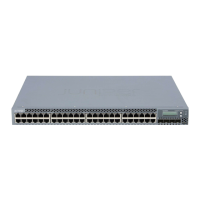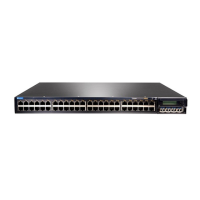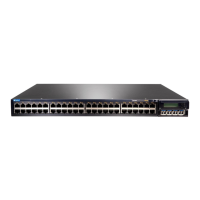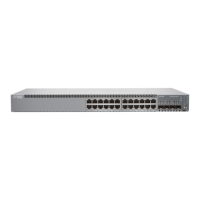Configuring Static ARP Table Entries
To configure static ARP table entries, include the arp statement:
arp ip-address (mac | multicast-mac) mac-address <publish>;
You can include this statement at the following hierarchy levels:
•
[edit interfaces interface-name unit logical-unit-number family inet address address]
•
[edit logical-systems logical-system-name interfaces interface-name unit
logical-unit-number family inet address address]
The IP address that you specify must be part of the subnet defined in the enclosing
address statement.
To associate a multicast MAC address with a unicast IP address, include the multicast-mac
statement.
Specify the MAC address as six hexadecimal bytes in one of the following formats:
nnnn.nnnn.nnnn or nn:nn:nn:nn:nn:nn; for example, 0011.2233.4455 or 00:11:22:33:44:55.
For unicast MAC addresses only, if you include the publish option, the router or switch
replies to proxy ARP requests.
NOTE: By default, an ARP policer is installed that is shared among all the
Ethernet interfaces on which you have configured the family inet statement.
By including the arp statement at the [edit interfaces interface-name unit
logical-unit-number family inet policer] hierarchy level, you can apply a specific
ARP-packet policer to an interface. This feature is not available on EX Series
switches.
When you need to conserve IP addresses, you can configure an Ethernet
interface to be unnumbered by including the unnumbered-address statement
at the [edit interfaces interface-name unit logical-unit-number family inet]
hierarchy level.
NOTE: The Junos OS supports the IPv6 static neighbor discovery cache
entries, similar to the static ARP entries in IPv4.
Example: Configuring Static ARP Table Entries
Configure two static ARP table entries on the router or switch’s management interface:
[edit interfaces]
fxp0 {
unit 0 {
family inet {
address 10.10.0.11/24 {
79Copyright © 2015, Juniper Networks, Inc.
Chapter 2: Configuration Tasks
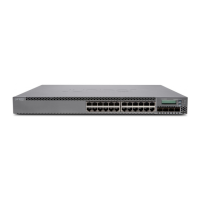
